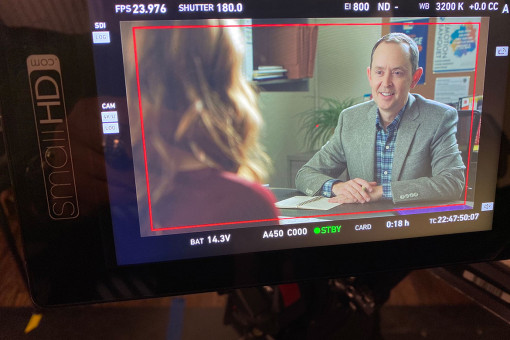Over the course of four years and 125 shoots, series producer Mark Brownlow and the crew of BBC America's Blue Planet II were looking for something.
Past the white caps that glimmer on the ocean surface, past the farthest reaches of sunlight, down to the alien creatures that populate the ocean's desolate floor.
At the fore of one of the most expansive undertakings in oceanic documentary cinema since the series's predecessor inspired awe worldwide nearly two decades ago, Brownlow set out to search for meaning in the deep.
At its core, Blue Planet II is equal parts a celebration of the oceans' ecosystem and an intrepid journey into the depths of maybe the most vibrant part of a planet we still understand very little about.
Such a massive venture requires tremendous preparation, not to mention manpower. Brownlow, whose producing credits stretch all the way back to Planet Earth in 2006, worked tirelessly with his team in the early months of production to ensure that every detail was properly arranged.
"We are very, very targeted and meticulous around what our subjects are. So much so that we will storyboard before even leaving the office. Such is the level of detail and scrutiny when we put our teams together and when we go out and tackle a subject," Brownlow said,
"To attempt anything physically, you have to be absolutely confident that you stand a good chance of success. It's all about risk analysis and seeing what we think is possible."
In an environment surrounded by the unknown, the possibilities become nearly endless. Faced with such a vast array of potential angles through which to explore the deep, Brownlow and company were tasked with garnering foresight in the face of uncertainty.
"We would go on location with a shot in mind, because that would give us the best chances of developing the right camera gear ahead of filming, so that you go to the set with the best equipment to realize your vision," Brownlow said.
Despite extensive planning, the mysteries of the deep are still unpredictable. While Blue Planet II's cameras may capture an almost otherworldly serenity in the blue, Brownlow admits a sort of anxiety is still prevalent behind the camera.
"It's incredibly nerve-wracking," Brownlow said, "What we're looking for are stories that would be brand-new to the audience. As a director, you're putting a lot of pressure on yourself to achieve your goal."
Regardless of the variables inherent in its production, the scope of Blue Planet II is undeniable. It's a spectacle accomplished through a staggering collection of resources, and captured by technology designed specifically for the task.
"We'll be talking to our global network of scientists, really analyzing whether or not a story was indeed filmable, and if it was indeed filmable, then the next two and a half years will be all around the logistics of getting the teams in a place to capture this unique moment in time," Brownlow said.
Once the daunting obstacles concerning the logistics of capturing the show's fantastical sights had been overcome, Brownlow and his team were yet to face the task of making the exploits of subterranean sea creatures compelling to those of us still walking on dry land.
"We had a challenge because, for me, the oceans are sort of 'out of sight, out of mind.' They're remote places, dark places," Brownlow said, "Our big challenge was to show to the world that the oceans are filled with these extraordinary animals, capable of intelligence and sophistication we never thought possible.
"It tells a story, not of outer space, but of inner space. There are huge amounts of life. To me, it just sort of amplified how rich the deep is."
Blue Planet II provides no shortage of mesmerizing imagery to pull viewers into its depths. Brownlow himself mused about his favorite of the events, which also happens to be one of the most rare: the boiling sea. It's an event rarely witnessed by human eyes, and Brownlow, along with his crew, went to great lengths to capture the phenomenon on film.
"We were lucky enough to be stationed 30 miles off shore on a research vessel with a helicopter pad. Every day we went up in the helicopter to try and find these boiling sea events. [It is] an event that takes place when millions of these fish called lanternfish, which are a deep sea fish, come up to the surface to spawn, they get trapped by dolphins and other predators. The water foams and splashes," Brownlow went on to describe the feeding frenzy that followed as, "…awe inspiring. Just the scale of it."
That very same awe inspiring scale has turned shows like Blue Planet II and many of its contemporaries into cultural sensations, with viewers around the world having been audience to the same sense of wonder that Brownlow experienced first-hand.
"It's a massive privilege and a huge responsibility to be charged with making the next Blue Planet for a generation," Brownlow said, "The original Blue Planet back in 2001 became sort of the underwater film bible. I think what it demonstrates is that globally, internationally, there's this fascination with what's going on in our natural world, and perhaps a sense of importance in this world, that people recognize the value of the world we live in."
Perhaps it is the sense of unknown in the deep that drives that fascination. As of this moment, only five percent of the Earth's oceans have been explored, according to the National Oceanic and Atmospheric Administration. For Brownlow and his colleagues, the mystery of what might lie in the corners of those unexplored territories presents an exciting prospect.
"We were the first the first people in history to explore and witness what's really down there in Antarctica. You recognize how far we've still got to go in terms of ocean exploration, over 90 percent to survey, film and explore, so I think it's a huge excitement in what's still down there," Brownlow said.
As to what might lie in the vast, unexplored expanse beneath the oceans' surface, Brownlow remains eager to find out.
"We know there's a squid that's bigger than the giant squid, called the colossal squid, that lives in Antarctica. Not that we've filmed one in the wild, or even seen it. We came across coral reef that would've been alive during the time of the Egyptian pyramids that have been razed. There's huge mysteries still to solve."




















